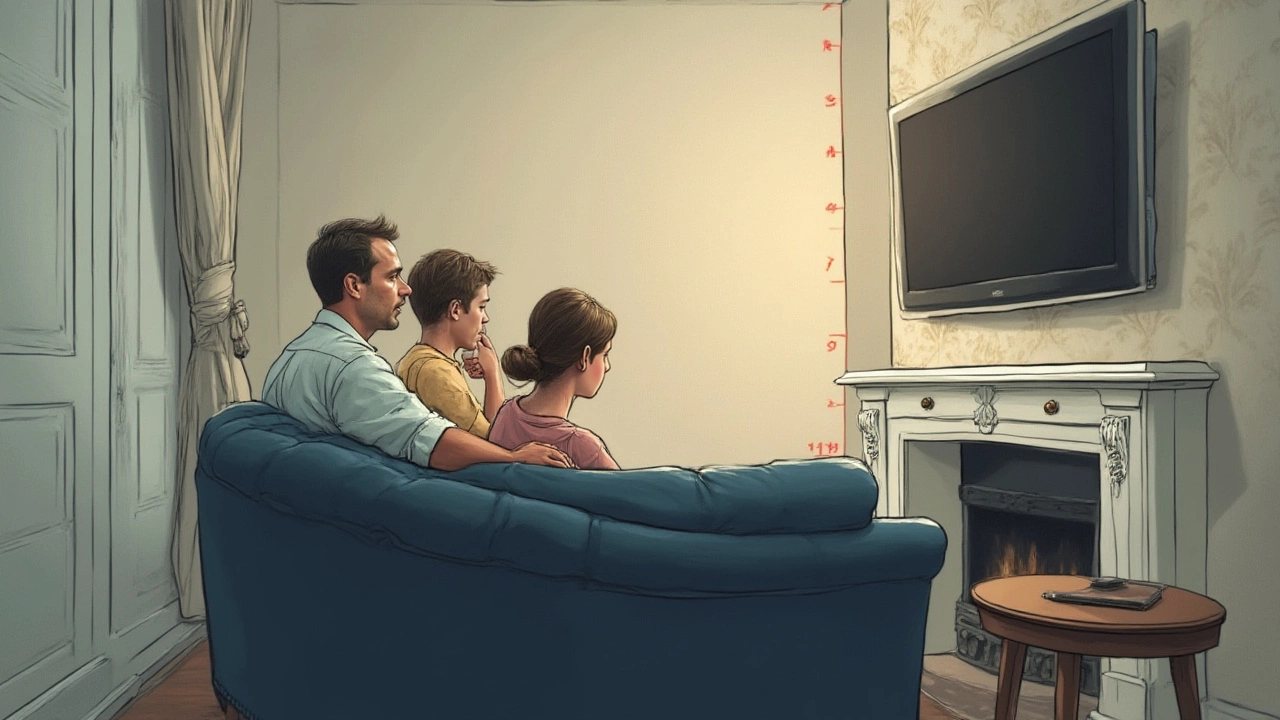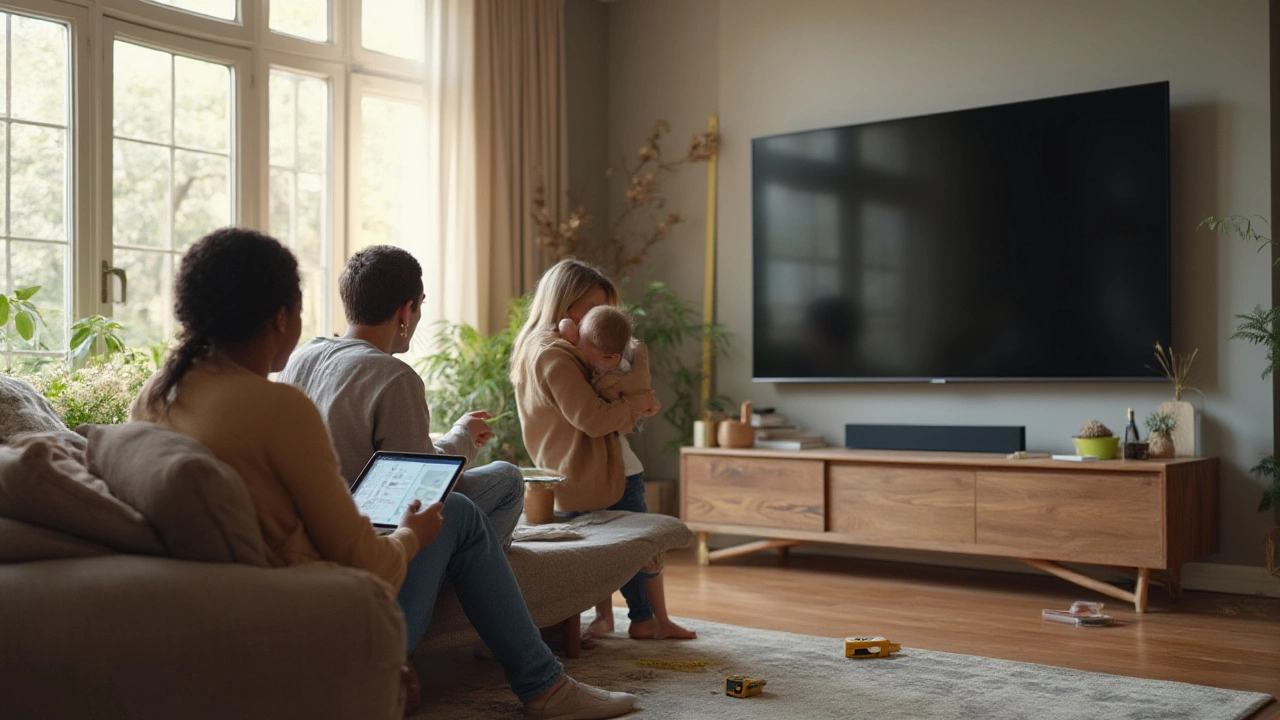You’d be surprised how many people hang their TVs way too high or low—just because they’ve seen it done that way. Picture this: it’s movie night, popcorn’s ready, but ten minutes in, your neck starts to ache. Not exactly the cozy setup you imagined, right? Here’s the real kicker: the right mounting height for a 55 inch TV isn’t just a matter of taste. It’s about science, comfort, and making every second in front of your screen just the way it should be.
The Science Behind Eye-Level and Why It Matters
Let’s get straight to the big question: how far off the floor should you mount a 55 inch TV? The sweet spot comes down to eye level when you're sitting. Experts and major TV brands like Samsung and Sony generally agree that the center of your TV screen should line up with your eyes while you’re planted on your couch. For most sofas, that means your eyes are about 40 to 42 inches from the floor. Considering a standard 55 inch TV is around 27 inches tall, you’ll often want the center of the screen to sit about 42 inches (give or take an inch or two) from the floor. Grab a tape measure and you’ll see that this usually means the bottom edge of your TV sits roughly 14 to 16 inches above the floor, depending on your TV’s actual size, the frame thickness, and your chair height.
Professional AV installers actually use formulas for this. Here’s a simple way to get close with no math headaches: for any TV, center the screen on your seated eye line. Why? Your eyes—and neck—will thank you. Our eyes naturally rest straight ahead. Crane your neck up or down even a few centimeters (or inches, if you're being dramatic) and after an episode or two, you’ll feel the difference. A 2019 ergonomics study from Ryerson University found that elevating TV screens by just five degrees led to twice as much self-reported neck strain. That’s not just a minor inconvenience; over time, it can lead to headaches and even recurring muscle pain. And almost everybody’s eye level sitting down falls right in that 40–42 inch window.
Still not convinced? Movie theaters and home cinema designers stick to this “eye level” rule for a reason. The Society of Motion Picture & Television Engineers (SMPTE) recommends the center of the screen be no more than 15 degrees above your line of sight for comfort. If you like numbers, that usually lands you back in the 40–42 inch range for most living rooms. Mississauga’s own Guzzo cinema chain uses a similar setup in their VIP theaters, making the experience as easy on your body as your eyes. So: measure your seating, measure your TV, and do the math—your next movie binge could feel like the VIP lounge, not an airport terminal.
Check out this quick stats table with average seating and screen heights for different spaces—just to see how it lines up with your home:
| Room Type | Average Seat Height | Recommended TV Center Height |
|---|---|---|
| Living Room | 18"–20" | 40"–42" |
| Home Theater | 16"–18" | 38"–40" |
| Bedroom (bed) | 22"–26" | 48"–52" |
Keep in mind—if you’re hanging a TV in a bedroom where you’re usually lying down, your eye-line may be higher than a couch. Adjust accordingly, and skip the standard living room height in that case.

How Room Layout and TV Habits Affect Ideal Height
One size does not fit all. Everyone’s living space is different. Maybe your sofa is super low and loungy, or you want to watch Netflix from a high-back recliner—not a problem, but you’ll want to measure your eye level from that spot, not just trust a general rule. If you have an open-concept living/kitchen area, you might occasionally watch TV while standing, chopping onions, or even while pacing (we all do it). In cases like this, think about your “average” eye level and pick a compromise that won’t leave you hunched over or craning your neck all the time.
Wall type can also throw a wrench into plans. If you’re living in a rental condo or a house with drywall over concrete, mounting is a bit trickier. Some folks end up mounting their TV higher just to catch a stud or avoid a heating vent. If that’s you—don’t panic. It’s still better to nudge your TV back toward eye level than to put it wherever is easiest to drill. Most modern mounts allow for some vertical wiggle room, so you can adjust afterwards. If you use a tilting mount (most basic ones can angle downwards up to 12 degrees), hanging your TV slightly higher isn’t as bad, since you can point the screen directly at your eyes. Just try to keep it within that magic 15-degree comfort zone, or your next movie night could become an Olympic neck stretch.
Room lighting and windows can also play a game with your TV height. Ever noticed a glare cutting across your screen at 3 PM in July? You might need to tweak your mount or move your curtains, but don’t let lighting force you to hang your TV too high. Instead, use blackout curtains or an anti-glare screen protector—your comfort is worth the small investment.
Here’s a checklist you can use, so you don’t miss the details:
- Measure your main seating spot’s eye level. (Sit, and measure the height from the floor to your eyes. Don’t cheat!)
- Check your TV’s exact height (from the manual or measure yourself, frame to frame).
- Find the halfway point of your TV’s height (center line).
- Mark that height on the wall at your measured eye level.
- Account for wall studs, vents, and outlets before drilling.
- Pick a mount with tilt if you can’t hit the perfect height (especially helpful for rooms where you want to see the screen from multiple spots).
Once you’ve got those settled, you don’t need to obsess over a few centimeters here or there. Your eyes and neck will forgive a little imprecision, as long as you’re not planting the TV up near the ceiling or setting it on the floor like a retro movie projector. Trust your own comfort—if you sit down and it feels right, you probably nailed it.

Troubleshooting Common Mistakes and Making the Setup Look Ace
You wouldn’t believe how many folks end up with a big, beautiful 55 inch TV…and then complain it “just doesn’t feel right.” Sometimes the picture quality suffers, other times, it’s just awkward to watch. Almost always, the mounting height is the culprit. The classic mistake? Hanging the TV how furniture stores do (literally, at standing eye level—so it’s easier for shoppers to see). Or, folks try to center the TV between the floor and ceiling because it “looks even.” The problem with both: neither takes actual viewing into account.
Another biggie: putting the TV above your fireplace. Real talk: unless your mantel is lower than most, this puts your screen way too high. A 55 inch TV above a standard mantel (typically 48–54 inches from the floor) means the center of your screen could be pushing 60 inches up. Not exactly neck-friendly. If you must mount above a fireplace (we get it, sometimes it’s the only open space), use a tilting mount—and angle the TV down as much as you can. Better yet, set up your seating farther away. The farther back you sit, the less you need to look up.
Here are some quick fixes if you already mounted your TV “wrong” and want to improve things:
- If your TV is too high and you have a tilting mount, point it downward toward your seats.
- Raise or lower your seating (add a cushion or swap in a taller/shorter couch).
- For wall-mounted soundbars, try to keep them just below the TV, not above.
- Use cable covers (paintable ones look sharp) to hide wires dangling down the wall—clean setup, less temptation to adjust mounting later.
- If you’re renting, consider a strong TV stand that keeps the screen at eye level (some models are height adjustable).
And for a polished look? Run cables through the wall if possible, use sleek shelves for your boxes and remotes, and always double check that the TV is level. There’s nothing worse than a crooked screen once you’ve got the height perfect.
One last thing: don’t chase trends. Just because a friend mounted their TV “gallery style” way up doesn’t mean you should. Stick with the comfort-forward formula—TV center at seated eye level for most living rooms, and adjust up or down depending on your habits and room quirks.
Bottom line: when it comes to 55 inch TV height, trust the numbers, trust a good tape measure, and most of all, trust your own comfort. Once your screen sits at the sweet spot, you might just notice action movies look a bit sharper, comedies get a little funnier, and your next binge-session marathon feels a whole lot better. Movie magic, made simple—no chiropractor needed.



